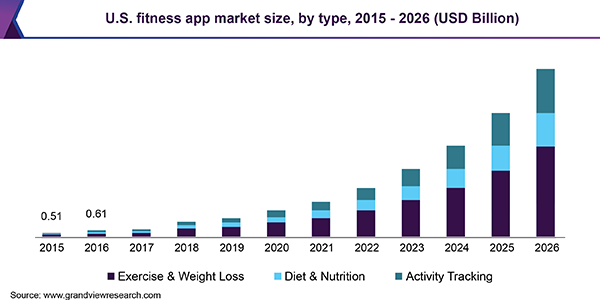
The high-speed life everybody is a witness to, imposes the fact that everything around us is rapidly changing and substitutable. If you are fed up with a gym you can quickly decide to try out another fitness facility with just the help of your signature. Nevertheless, our digitally transformed world introduced the fitness apps, which grant you access to millions of exercises from the comfort of your favorite device. It does not matter whether you prefer indoors or outdoors activities, because there is an abundance of apps in both variations.
Digital health has turned into a successful business that attracts industries even from the outside of healthcare. Sport apparel giants also opted for creating exercise apps offering different types of workouts plus shopping vouchers. Brands such as Nike, Adidas, Under Armour offer evaluation of your workout based on the shoes you are wearing! The mergers and acquisitions are no strangers to this sphere, too. Namely, in August 2015, Adidas acquired Runtastic, an independent app tracking your running routine, for USD 239 million. Moreover, the global fitness app market size is estimated to reach a staggering USD 14.64 Billion by 2027.
The following chart illustrates the predictions for the market. As you can see the market has been segmented into exercise & weight loss, diet & nutrition, and activity tracking. Predominantly preferred in 2018 was Exercise & Weight loss. Whereas activity tracking is anticipated to witness the fastest growth over the forecasted period.

But, what is there that makes them so attractive?
They eliminate cost and expenditure
Some apps are paid or they have premium features. Despite this, the cost of actually going to a gym for the majority of people is much more than the monthly app subscription. Eliminating your transportation cost and hefty gym membership is going to help you save money and make you discover that working out is not limited to the gym only. This leads us to the following advantage.
Time-saving
With cutting out the commuting part of your “workout”, fitness apps allow you to cherish more free time. Plus, the vast majority of the workouts are between 5 to 45 min, which is definitely much less than the period of time people usually spend at the gym. However, don’t be fooled by the time limit, these exercise routines are pretty intense.
Comfortable
As you can carry your phone around at all times, you can take advantage of the apps. Just simply decide when and where to perform your workouts. People who still continue working out on their holidays (definitely not one of them) may turn this into their best fitness buddy, too.
Meal plans
Most of the fitness apps include a premade or even personally tailored meal plan, adjustable to your needs for free. Of course, there are apps with many more features such as tracking daily calorie intake to a macronutrient level, such as fats and carbohydrates. Also, daily reminders can help you stay on track with your diet.
Fitness apps and devices (bonus point)
Let’s take Fitbit for an example. The growing demand for portable health is leading to the expansion of the wearable technology market. In March 2019, Fitbit launched four wearables with costs ranging from around USD 70 to USD 160. They provide affordable activity tracking, which evaluates the user’s stats & progress. Furthermore, a lot of digital watches can connect to your app or device, without having the need for being the same brand.
In conclusion, the fitness app market is bound to expand, not only due to the increase of mobile usage but also the global pandemic has caused the closure of a lot of fitness venues, thus leading everybody to opt for online help. If you have an idea in mind, don’t hesitate to contact us and unleash your dream workout project. Stay healthy!
